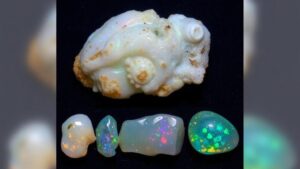The Rainbow Rocks: Unearthing Iridescent Labradorite in Volcanic Fields
The Rainbow Rocks: Unearthing Iridescent Labradorite in Volcanic Fields
Labradorite, often referred to as the rainbow rock, is a captivating feldspar mineral renowned for its striking visual phenomena known as labradorescence. As rockhounds and mineral collectors delve into volcanic fields, understanding the geology and characteristics of labradorite becomes paramount to unearthing this iridescent treasure. This article will explore the formation of labradorite, the locations where it is commonly found, methods for identification, and tips for collectors eager to add this stunning mineral to their collections.
Formation and Geological Context
Labradorite is primarily formed in igneous rocks, particularly those with a high sodium and calcium content. This mineral crystallizes from the cooling of magma that seeps into the Earths crust during volcanic eruptions. As the magma cools, the feldspar crystals–of which labradorite is a member–begin to grow. The unique play of color within labradorite occurs due to the microscopic layers within the crystal structure that reflect light differently. Laboratory studies suggest that the thickness of these layers can vary from 10 to 100 nanometers, contributing to the spectacular color display.
Notable Locations for Labradorite Discovery
While labradorite can be found in various locations worldwide, several regions are particularly famous for high-quality specimens:
- Canada: The Paul M. R. Hilton Mineral Collection on the coast of Labrador is notably the source of the minerals name, yielding some of the finest specimens.
- Madagascar: Known for vibrant colors and large crystal sizes, Madagascars deposits feature labradorite with exceptional brightness.
- Finland: The spectrolite varieties found in Finland display unique and vibrant optical qualities, making them highly sought after by collectors.
According to geological surveys, the concentration of labradorite can be particularly high in volcanic regions, with some sites yielding over 30% labradorite in certain rock formations.
Identifying Labradorite: Key Characteristics
For rockhounds eager to collect labradorite, distinguishing it from similar minerals is critical. Here are some essential identification tips:
- Visual Inspection: Genuine labradorite displays a wide range of colors: blues, greens, and golds can be seen shimmering on the surface when light hits it at different angles, an effect known as labradorescence.
- Hardness: Labradorite registers a 6 to 6.5 on the Mohs hardness scale, making it relatively durable compared to softer minerals.
- Cleavage: This mineral has two distinct cleavage planes at 90 degrees, appearing as smooth, flat surfaces on the crystal.
Industry experts suggest using a dichroscope, an instrument that reveals the different colors in the mineral, to enhance identification accuracy. This technique allows for the visualization of the unique play of color that labradorite is celebrated for.
Real-World Applications of Labradorite
Aside from being a prized mineral for collectors, labradorite has several real-world applications. In the realm of jewelry making, its iridescence makes it a popular choice for pendants, earrings, and other adornments. Also, labradorite is often used in decorative stonework, where its aesthetic qualities can enhance various interior designs.
Practical Tips for Collectors
As you embark on your journey to collect labradorite, consider the following practical tips:
- Research Locations: Understand the geology of your chosen collection sites and familiarize yourself with areas where labradorite is likely to be found.
- Optimal Conditions: Visit after rainfall or during the spring thaw when erosion may expose new specimens in volcanic fields.
- Safety First: Wear appropriate gear and be aware of your surroundings when collecting in volcanic areas. Some sites may be remote or potentially hazardous.
Conclusion
Labradorite remains one of natures most intriguing treasures, enchanting collectors with its mesmerizing display of colors. By understanding its geological formation, honing identification skills, and following practical collecting tips, rockhounds can successfully unearth these radiant fossils of Earths fiery past. With careful exploration and a discerning eye, the quest for labradorite can undoubtedly lead to remarkable discoveries–making every rockhounds collection shine just a little brighter.



